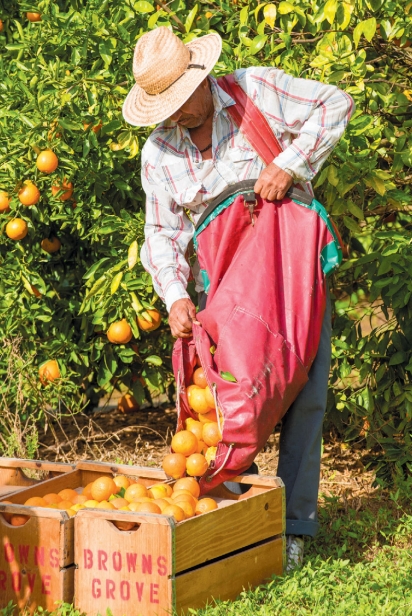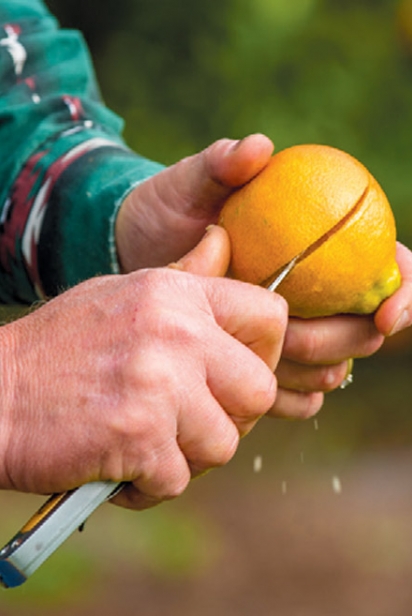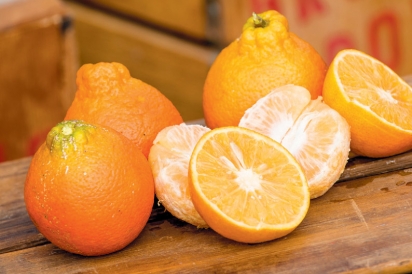How Sweet It Is Sugar Belles at Brown’s Grove
“We have a good feel for what the citrus consumer is looking for,” says Tim Brown, third-generation citrus grower and owner. Beyond the obvious—good flavor—Brown says most customers trend toward convenience, which in the citrus world means easy-to- peel, seedless, and easy-to-section varieties.
Brown may have been slightly ahead of the market demand when he made a move six years ago to become one of the first Florida citrus growers to obtain licensing for Sugar Belles, a cross between the bold-flavored Honeybell (also called a Minneola) and the easy-peel, seedless Clementine (a cross between a mandarin and sweet orange).
“As soon as I read about them we got them,” says Brown, who says reading was enough for him to recognize the potential and obtain licensing before tasting them. “It was a good decision,” he maintains.
With a robust flavor, distinctive bell-shaped end, and an easy-to-peel and seed-free nature, the Sugar Belle lives up to its reputation. It has even been dubbed “the fine wine of oranges” by Peter Chaires, executive director of the New Varieties and Development Corporation, which grants licensing rights on the citrus. But unlike the “notoriously” juicy Honeybell, you won’t need a bib to eat it.
“What makes it uniquely different is it is an easier piece of fruit to eat on the go,” says Brown. “It’s the type of fruit you can put in a kid’s lunch box and send to school.”
Brown’s starts harvesting Sugar Belles in December and the season lasts through January—a slightly earlier and longer season than Honeybells. Brown’s Grove is currently host to about 700 Sugar Belle trees, most of which are producing fruit. Citrus trees can yield fruit in three years but reach full production in seven to nine. Because Brown’s has been growing Honey Belles for six years now, they have that slight gain on local availability and they certainly know a lot about growing them. Still, Brown says he’s constantly learning. For example, he’s noticed production can fluctuate from season to season. One year it’s a smaller fruit but higher yield, the next it’s bigger fruit but not as many.
Because the Sugar Belle is a patented variety (developed by the University of Florida), Brown pays a royalty on each tree he plants. Despite this added cost, he says it has been a worthwhile investment.
“These newer varieties are showing promise to stand up to diseases like greening,” says Brown, which is great news for a local industry that’s encountered major technological advances, import competition, and Mother Nature’s fury over the last few decades.
In addition to Sugar Belles, Brown’s Grove also grows a newer variety of seedless mandarin called a Tango Tangerine—comparable to the California Cuties you see in grocery stores. The Tango also produces through January.
All 60 acres of Brown’s Citrus Grove fruit is hand-picked and used for fresh-fruit sales—no fruit goes to juice plants. Brown’s does not use gas on its fruit, so while customers may notice a slight green tone to some of the peels, this is not an indication of the ripeness or health of the fruit. In fact, often all it takes is one cold snap to help bring on a more vibrant orange color.
To get some Brown’s Grove fresh citrus, head to Phillippi Farmhouse Market on Wednesdays or the Sarasota Downtown Farmers’ Market on Saturdays. They also have a farm store located at 12255 US Highway 301 in Parrish, or order fruit to have it shipped on their website, brownsgrove.com.
PECANS PLEASE
In addition to his citrus groves in Florida, Tim Brown makes frequent trips to Georgia to manage a pecan grove he helped plant a few years ago. Because those trees are young, that grove is not yet producing, but Brown doesn’t dare return emptyhanded. On each trip when they are in season, Brown brings back anywhere from 30 to 60 pounds of fresh Georgia pecans to sell at market.
Choose between two varieties of fresh shelled and halved pecans: the Elliot, a smaller nut with a higher oil content good for fresh eating; and the Pawnee, a larger pecan predominantly grown in Florida and Georgia. Although pecans come in season starting in October, the nuts can be refrigerated or frozen all year long. And if you’re craving pecan candy, Brown’s can help with that, too.








